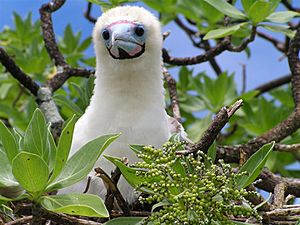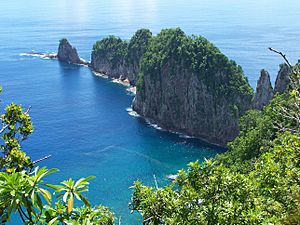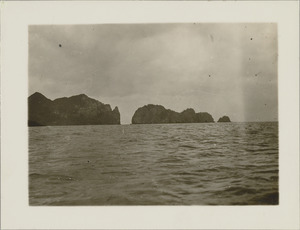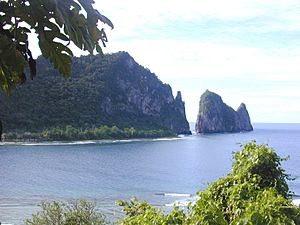Pola Island facts for kids
Pola Island (which is called Motu o Pola in Samoan) is a small island located just off the coast of Vatia village on Tutuila Island in American Samoa. It's also known by the cool name of Cockscomb because of its shape.
Pola Island is a super important part of the National Park of American Samoa. It's a popular spot for tourists to visit. You can find it on the west side of Vatia Bay, and it's a famous landmark for the village. People love Pola Island so much that Pago Pages named it one of American Samoa's Seven National Wonders! The travel guide Lonely Planet even called it "the most beautiful natural feature of Tutuila Island." Pola Island is famous for its tall cliffs, which are home to many seabirds. It's one of the main places where seabirds build their nests in American Samoa.
Contents
The Story Behind the Name
The name Pola Island comes from an old legend about how the village of Vatia was created. A long time ago, a couple named Pola and Pola, along with their daughter Faleofia, sailed from the Manu'a Islands. They hoped to reach Upolu Island.
After a few days, they faced really rough seas, and their raft broke apart. Sadly, all three of them were lost at sea and turned into rocks. The rock formations you see today are named after this brave couple.
You might hear two names: Pola'uta and Pola Tai. "Uta" means "closer to land," so Pola'uta is the name of the ridge on the land side, across a narrow water channel. "Tai" means "further from land," and that's why Pola Tai is another name for Pola Island itself.
Island Features and Formation
Pola Island is separated from the main land by a narrow channel called the Vai'ava Strait. This strait is part of the Vai'ava Strait National Natural Landmark, which covers 250 acres. It's the only U.S. National Natural Landmark in American Samoa that is also part of the National Park.
If you drive east through Vatia village, the road ends at the path to Pola Island. A short walk leads you to a beach with many smooth, rounded stones. From the bottom of the cliffs, you can see two natural arches in the sea.
There's a special spot called Pola Scenic Point on the road leading into Vatia. From here, you can get amazing views of Pola Island and the Vai'ava Strait. Pola Island is a tall, pointed rock made of basalt. It has very steep cliffs and forest-covered hills. It's a super important place for at least eight different types of seabirds to nest. All of Pola Island and the eastern parts of Pola'uta Ridge are covered in untouched forest.
Over time, the ocean has carved out the cliffs and sea arches in the rocks of Pola Island. This huge rock is actually an old volcanic plug. The rock shapes of Pola Island look a bit like a dinosaur's tail sticking out 3,500 feet into the sea! It's a rough and sharp rock formation made of igneous basalt.
How to Visit Pola Island
If you want to see Pola Island, you can drive east through Vatia village. The path to the island is at the very end of the road, past the school. A short trail takes you into the National Park. The trail ends at a rocky cliff that looks across the Vai'ava Strait toward Pola Island. You can't actually go onto the island itself.
Some companies, like North Shore Tours, offer boat trips around Pola Island. It's the most photographed spot on Tutuila Island, so get your cameras ready!
Weather on Pola Island
The area around Pola Island gets a lot of rain, usually from 149 to 252 inches (about 378 to 640 cm) every year. The temperature stays pretty warm, usually around 71-73 degrees Fahrenheit (21-23 degrees Celsius).
Amazing Wildlife
Seabirds and Their Homes

The cliffs of Pola Island are 394 feet (about 120 meters) high and are full of seabirds. Pola Island is known as American Samoa's "top seabird nesting site." Pola Island and the nearby Pola'uta Ridge are the most important places for many types of seabirds to nest and rest in American Samoa. For example, the only places where Red-footed boobies raise their young in American Samoa are Rose Atoll and the Pola Island area, including Pola'uta Ridge.
The Pola region near Vatia is a crucial spot for many seabird species. Some of the birds you might find here include:
- Red-footed booby (Sula sula)
- Brown booby (Sula leucogaster)
- Greater frigatebird (Fregata minor)
- Lesser frigatebird (Fregata ariel)
- Brown noddy (Anous stolidus)
- Black noddy (Anous minutus)
- Blue-gray noddy (Drocelstema cerulea)
- Gray-backed Tern (Stema lunata)
Bridled terns don't visit American Samoa very often, but they have been seen at Pola Island. Pola Island is the main breeding area for boobies and frigatebirds on Tutuila Island.
A Look Back at Hunting Traditions
In the past, people used to hunt Brown boobies, which they called A'ega o le Pola. However, too many birds were hunted because people started using shotguns. Because of this, the birds disappeared from the Pola area for a while. Luckily, they have started to return recently. The eggs from Brown boobies were once a special treat for the people living in nearby Vatia.
Images for kids
-
In American Samoa Red-footed boobies are only found in the Pola area and Rose Atoll.















